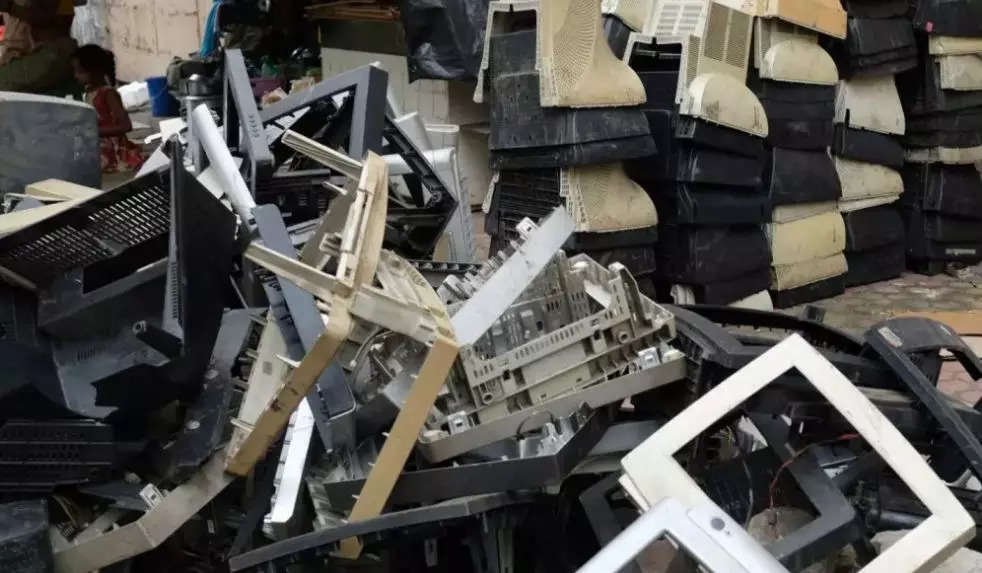
Due to the sheer expansion of the IT and communications industries, the use of electronic equipment has increased dramatically across India including Delhi-NCR region. The growing e-waste problem calls for a greater emphasis on recycling and better e-waste management.
E-waste is an electric device that is discarded, becomes obsolete, or breaks down. People keep the majority of obsolete electronics at home because they don’t know how to properly dispose them. Although the problem of this ever-increasing e-waste is complex, yet it provides great value as these e-wastes are a rich source of precious metals that can be recovered and reincorporated into the manufacturing process.
According to a Market Research report, the Indian e-waste management market is rapidly expanding and is expected to grow at a CAGR of 14.25 percent in terms of revenue and 8.24 percent in terms of volume between 2021 and 2026. According to the report, rising government initiatives, raising awareness, and environmental concerns are driving the market’s growth.
E-waste Problems in India
In the World Bank ranking for environmental protection in 2022, India is among the bottom five countries out of 180 countries in the world with a dismal rating of 18.9. This was linked to poor performance in the environmental health policy and deaths caused by air pollution. In addition, with approximately 3 million metric tonnes of e-waste produced annually, India is quickly becoming one of the world’s largest electronic markets.
Delhi NCR is home to some of India’s largest e-waste recycling facilities. Adults and children both spend 8 to 10 hours per day removing functional and reusable parts, as well as precious metals such as copper and gold, from devices. E-waste recycling companies use techniques such as open incineration and acid-leeching. This situation could be improved by increasing awareness, improving recycling unit infrastructure, and implementing new policies. The majority of waste collected is managed by unorganized sector. In addition, a significant portion of discarded electronics is collected by informal recycling and reuse channels, such as repair shops and e-commerce portal vendors, for reuse and cannibalization of parts and components.
People frequently dump their waste in open dump sites, resulting in groundwater contamination, poor health, and other issues. According to the joint study conducted by the Associated Chambers of Commerce and Industry of India and KPMG, computer equipment accounts for nearly 70% of all electronic waste, with the remainder coming from household sources such as electrical and medical equipment in India. Waste collection, transportation, processing, and recycling are all dominated by the informal sector. The industry is extremely interconnected and unregulated. Often, not all the materials and values that could be recovered are recovered. There are also significant issues with toxin leaks into the environment, as well as worker safety and health.
E-Waste Disposal and Management
It’s important to remember that e-waste reduction is about more than just reducing environmental risks. Recycling e-waste components requires far less energy than manufacturing new ones, thereby conserving resources and lowering the energy required to manufacture these goods.
Here is how businesses can reduce and manage e-waste.
Reduce purchases and organise them accordingly: The most common source of e-waste is the purchase of goods. Organize your existing electronic devices and avoid purchasing anything that cannot be reused or destroyed by the maker. Choosing recyclable or long-lasting electrical products is a long-term strategy for e-waste management. Even after you wipe your electronic devices, your personal information is still stored on them, which is another reason to keep them. Before recycling your device, recycling facilities can clean it, protecting the data from hackers.
Cloud Storage: It is not necessary to buy a large server or storage system for personal or commercial use. Cloud data solutions provide server that are ideal for archiving and synchronizing data across multiple devices.
Donate and Re-sold: If you don’t need an electronic device, donate it so that someone else can use it. Donations are tax-deductible because the amount is usually close to the asset’s resale value. If not for donations, see if the store will buy your old camera, computer, or related products before purchasing a new one. In a buy-back program, the consumer and the seller enter into an agreement in which the seller promises to purchase the product being sold at a later date. Many companies will gladly buy your used products such as wearable devices, consoles, and other electronic devices. They provide services, such as money, in exchange for merchandise.
There is no quick fix for e-waste—we’ll have to deal with it sooner or later—so take advantage of it now. Because of rapid technological advancements, electronic products become obsolete daily, and it is best to sell any unused electronic device to avoid clutter and loss in the future.
Paving the way for future: With the changing landscape, customer behaviors are also altering in terms of purchasing new ones, to emphasize that used devices should be reused rather than discarded. So the use of landfills for electronic waste puts the environment in danger. Recycling, on the other hand, has a lot of advantageous effects on the environment. You could also donate these devices to a reputable company with a long history of ethically recycling electronic waste.
The e-waste management industry in India is undergoing a complete transformation. Managing e-waste is an environmental challenge, despite notable differences between high-income, transitional, and developing countries. People all over the country are helping to collect, treat, recycle, and dispose of this rapidly expanding waste stream in ways that are safe for both human health and the environment.
(The writer is Founder and CEO, Deshwal Waste Management)